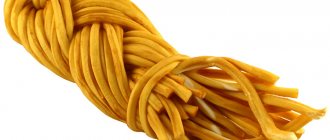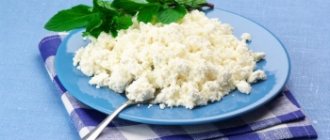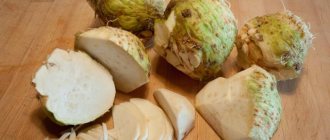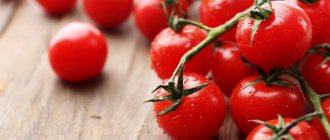The history of the bay leaf
The evergreen laurel tree grows in subtropical and tropical regions. It can be found in the Mediterranean and Transcaucasia, on the Canary Islands, in Asia Minor. The leaves of the plant are highly valued in cooking - they are one of the most famous seasonings. The plant is noteworthy for its healing and even occult properties; laurel is a symbol of victory in many world cultures.
A beautiful ancient Greek myth is associated with the laurel tree, telling about the origin of the plant. According to Ovid, one day the god Eros punished Apollo by shooting him with an arrow of love for the nymph Daphne, and at Daphne herself with an arrow that kills love. The nymph's persecution by Apollo only disgusted her, and she ultimately asked the gods to protect her. The gods fulfilled their wish by turning Daphne into a tree. The saddened Apollo made sure that the laurel remained evergreen, and the plant has since become sacred.
Harm and contraindications for use
Laurel leaves are considered invaluable assistants in the treatment of many diseases, but it is necessary to take into account that, like any product, they have a number of contraindications.
- People prone to allergies should avoid the product.
- Women are also at risk during pregnancy, as laurel leaves increase the activity of the uterus, which provokes miscarriage and premature birth.
- Nursing mothers should for a certain period of time avoid using the spice in cooking, as well as for medicinal and cosmetic purposes, as it gives milk an unpleasant bitter taste.
- Patients suffering from diseases of the kidneys, liver, heart and blood vessels need to find an alternative to this spice.
- Limit the use of the product to patients diagnosed with renal failure or impaired protein metabolism.
- Exceeding the specified dose can lead to poisoning of the body with vomiting, heart rhythm disturbances, breathing problems and an allergic rash. And if consumed simultaneously with milk and dairy products, it can cause stomach upset.
- With prolonged use, due to its astringent properties, the plant can cause constipation.
Uncontrolled use of laurel can cause health problems. Therefore, before starting treatment, you should assess the possible benefits and harms of the spice.
Chemical composition of bay leaf
The benefits of bay leaves for the human body are easily explained - just look at the composition. Plant leaves contain:
- vitamins A and C;
- B vitamins;
- PP acid and saturated fatty acids;
- esters and tannins;
- potassium and iron;
- magnesium, copper, zinc and sodium;
- phosphorus and manganese;
- cellulose.
The plant not only improves the taste and aroma of dishes, but also gives them additional beneficial properties.
Used in recipes:
Lentil soup Onion soup with cheese Fish cakes Turkey salad with grapes and mango Chicken in red wine Chicken eintopf (thick soup) Italian specialty of pork and pasta Sausages baked with lentils and vegetables Chicken curry Beer goulash Tomato and eggplant crumble Penne with eggplant and garlic sauce Pumpkin soup Curry with tuna Tuna with thyme Pork with curry and pineapple Chicken thighs in beer with beans Mediterranean chicken Beef stew Potato stew Chicken schnitzels in red wine Soup with smoked salmon Beef ham in red wine Chicken on skewers with zucchini, champignons and sausages Fish soup with sweet pepper
| Navigation: All recipes |
- Prophet Test Do you have the ability to see the near future?
- Flags of the world Do you know the flag of your country? And the flag of the country where are you going to go on vacation?
- Test by countries of the world The database contains detailed information about 199 countries of the world
- Test: Neighboring Countries Take a test to test your knowledge of neighboring countries. Find out which countries border your country
- Test on road signs Test of knowledge of Road signs according to the rules of the road (traffic rules)
- Human visual memory test Determine the level of your visual memory by answering the questions of our free online psychological test
- Free IQ test Intelligence Quotient (eng. IQ - intelligence quotient) - a quantitative assessment of a person’s level of intelligence
- Big IQ test With us you can take an IQ test (intelligence test) for free!
- Geography Test: Continents The database contains detailed information about 199 countries of the world!
Free games online · Eng · CZ Hry · Games online for free · Icon on your Web · Visitors' book · RoboStav Copyright (c) 2020 by Topglobus.ru. All rights reserved!
Healing properties of bay leaf
The valuable composition of the plant means that bay leaf brings great health benefits. Namely:
- improves appetite and helps digest food;
- significantly speeds up metabolic processes;
- strengthens the body's defenses against colds;
- removes toxins, waste and excess salts;
- relieves inflammation and pain;
- improves skin color and elasticity, strengthens hair;
- normalizes blood pressure and helps fight swelling;
- improves the condition of blood vessels and the cardiac system.
Calorie content Bay leaf. Chemical composition and nutritional value.
Nutritional value and chemical composition of "Bay leaf".
The energy value of bay leaf is 313 kcal.
- tbsp, crumbled = 1.8 g (5.6 kcal)
- tsp, crumbled = 0.6 g (1.9 kcal)
Primary source: USDA National Nutrient Database for Standard Reference. Read more.
** This table shows the average levels of vitamins and minerals for an adult. If you want to know the norms taking into account your gender, age and other factors, then use the “My Healthy Diet” application.
What are the benefits of bay leaf?
- Vitamin A
is responsible for normal development, reproductive function, skin and eye health, and maintaining immunity. - Vitamin B2
is involved in redox reactions, helps to increase the color sensitivity of the visual analyzer and dark adaptation. Insufficient intake of vitamin B2 is accompanied by impaired condition of the skin, mucous membranes, and impaired light and twilight vision. - Vitamin B6
is involved in maintaining the immune response, processes of inhibition and excitation in the central nervous system, in the transformation of amino acids, the metabolism of tryptophan, lipids and nucleic acids, promotes the normal formation of red blood cells, and maintaining normal levels of homocysteine in the blood. Insufficient intake of vitamin B6 is accompanied by decreased appetite, impaired skin condition, and the development of homocysteinemia and anemia. - Vitamin B9
as a coenzyme is involved in the metabolism of nucleic acids and amino acids. Folate deficiency leads to disruption of the synthesis of nucleic acids and proteins, resulting in inhibition of cell growth and division, especially in rapidly proliferating tissues: bone marrow, intestinal epithelium, etc. Insufficient folate intake during pregnancy is one of the causes of prematurity, malnutrition, and congenital deformities and child development disorders. A strong relationship has been shown between folate and homocysteine levels and the risk of cardiovascular disease. - Vitamin C
is involved in redox reactions, the functioning of the immune system, and promotes the absorption of iron. Deficiency leads to loose and bleeding gums, nosebleeds due to increased permeability and fragility of blood capillaries. - Potassium
is the main intracellular ion that takes part in the regulation of water, acid and electrolyte balance, and is involved in the processes of conducting nerve impulses and regulating blood pressure. - Calcium
is the main component of our bones, acts as a regulator of the nervous system, and is involved in muscle contraction. Calcium deficiency leads to demineralization of the spine, pelvic bones and lower extremities, increasing the risk of developing osteoporosis. - Magnesium
is involved in energy metabolism, the synthesis of proteins, nucleic acids, has a stabilizing effect on membranes, and is necessary to maintain the homeostasis of calcium, potassium and sodium. A lack of magnesium leads to hypomagnesemia, an increased risk of developing hypertension and heart disease. - Phosphorus
takes part in many physiological processes, including energy metabolism, regulates acid-base balance, is part of phospholipids, nucleotides and nucleic acids, and is necessary for the mineralization of bones and teeth. Deficiency leads to anorexia, anemia, and rickets. - Iron
is part of proteins with various functions, including enzymes. Participates in the transport of electrons and oxygen, ensures the occurrence of redox reactions and activation of peroxidation. Insufficient consumption leads to hypochromic anemia, myoglobin deficiency atony of skeletal muscles, increased fatigue, myocardiopathy, and atrophic gastritis. - Manganese
is involved in the formation of bone and connective tissue, and is part of enzymes involved in the metabolism of amino acids, carbohydrates, and catecholamines; necessary for the synthesis of cholesterol and nucleotides. Insufficient consumption is accompanied by slower growth, disturbances in the reproductive system, increased fragility of bone tissue, and disturbances in carbohydrate and lipid metabolism. - Copper
is part of enzymes that have redox activity and are involved in the metabolism of iron, stimulates the absorption of proteins and carbohydrates. Participates in the processes of providing oxygen to the tissues of the human body. Deficiency is manifested by disturbances in the formation of the cardiovascular system and skeleton, and the development of connective tissue dysplasia. - Zinc
is part of more than 300 enzymes and is involved in the processes of synthesis and breakdown of carbohydrates, proteins, fats, nucleic acids and in the regulation of the expression of a number of genes. Insufficient consumption leads to anemia, secondary immunodeficiency, liver cirrhosis, sexual dysfunction, and the presence of fetal malformations. Research in recent years has revealed the ability of high doses of zinc to disrupt the absorption of copper and thereby contribute to the development of anemia.
Application
And yet the main purpose of the bay leaf is to improve culinary dishes. It is most used in Mediterranean and Black Sea cuisines. This spice is ideal for meat dishes, for cooking broths, and for marinades and preserves. Great for flavoring vinegar and oils.
Secondarily, bay leaves are used in pest control - this method is safe for humans and environmentally friendly. There are also a huge number of recipes for using bay leaves for medicinal purposes.
Market Analytics
- COVID-19 is changing the rules of the game in the cosmetics market
- Beauty of the future: cosmetic innovations 2020
- New ingredients are the driving force of the cosmetics industry
Convenient search for beauty salons on our website
Beauty salons in Moscow Beauty salons in St. Petersburg Beauty salons in Ekaterinburg Beauty salons in Novosibirsk
Latest blog posts on our website
- Naturecream / Geranium (Pelargonium) oil for skin health and beauty
- Prostye-sovety / Save on a beauty salon: procedures that can be done at home
- Naturecream / Growth Factor - brings back youth?
- Oksana-Lezina / 3 effective abdominal exercises from a fitness instructor for beginners
- Prostye-sovety / Making perfect curls at home
- Prostye-sovety / Which hair removal method to choose
- Naturecream / Wrinkles Puppets
- Naturecream / PEPHA-TIGHT - instant skin lifting
- Naturecream / Blue light - a danger to the skin
- Naturecream / Cocoa Butter – A treat for the skin
Latest forum topics on our website
- Mrs._Smith / Badly sunburned! What to do?((
- Ice / Is it necessary to combine fitness classes with a diet?
- Antonova / What can be used for hair loss?
- Radio operatorKat / Who was on a protein diet?
- Suzanna / Mesotherapy on the face
Other articles in this section
| Adjika Adjika is a spicy Caucasian seasoning in the form of a paste containing garlic, salt, red pepper and various herbs. It is often red in color, but can be green when using unripe peppers. According to one version, the word “adzhika” is translated from Abkhazian as “red salt”, according to another – as “bread with salt”. |
| Vanillin For the vast majority of people, vanillin is a crystalline powder with a specific rich vanilla aroma. The demand for vanilla is much higher than the possibility of obtaining a natural product. Therefore, people had to use chemical reactions to reproduce artificial vanillin to satisfy all the needs. |
| Mustard Mustard is the oldest and favorite seasoning of many gourmets. Even Hippocrates mentioned it in his writings. It is a mixture of seasoning from whole or ground grains with water, vinegars and other ingredients, which are often: sugar, salt, olive or vegetable oil. The seasoning is revered in Russian and German cuisine. The difference between Russian mustard is its spiciness. |
| Saffron The spice that can be called the most expensive in the world is saffron. For its production, exclusively the stigmas of crocus flowers are used, which are crushed for this purpose. |
| Baking soda Baking soda (or otherwise scientifically known as sodium bicarbonate), whose chemical formula is NaHCO3, is a non-toxic crystalline substance, most often sold as a fine, odorless, salty powder (lye). As a result of chemical reactions, sodium carbonate salt precipitates, water is separated and carbon dioxide is released. The reaction is weak, therefore absolutely safe for humans, animals and plants. |
| Cane Sugar Sugarcane is a cereal plant that is similar in appearance to bamboo. Its juice is used to make sugar. Sugar cane originated in India, later began to be cultivated in the Middle East, after which the Arabs brought it to the Mediterranean countries. Sugar appeared in Russia under Peter I, when it was very expensive and candies made from it were available only at the royal court. At the same time, sugar was also sold as a medicine. The development of its industrial production began with the growing popularity of tea. |
| Apple cider vinegar 3% Apple cider vinegar is vinegar obtained by fermenting raw materials from apples. Moreover, it has a richer taste than alcohol. Apple cider vinegar is mild in taste and aromatic. |
| Cardamom This spicy seasoning has been known since ancient times. Cardamom was credited with healing properties. It was believed that it could relieve migraines, colds, and cure liver and intestinal diseases. Greek winemakers could not imagine drinks without cardamom grains. In the Middle Ages, the fruits began to be used for salting meat and fish. Until now, it is popular all over the world and in terms of sales - it ranks second after black pepper. |
| Jasmine Jasmine (Latin name: Jasmнnum) is a member of the olive family (Oleaceae). A close relative of lilac and ash. It is a low (no more than 2 m in height) evergreen shrub that sheds its leaves, growing in warm climates. In Russia, jasmine is found only in Crimea and the Caucasus. In the temperate zone, in dachas, it is not jasmine that grows at all, but mock orange from the hydrangea family, characterized by a richly sweet aroma of flowers. This feature is also characteristic of jasmine. Its flowers differ from lilacs in having 5 petals and they bloom at night. It is during this period or early in the morning that they are collected. |
| Dried basil Basil is a spicy aromatic seasoning, known since ancient times and coming to us from eastern countries. In India, basil was revered as a sacred plant and was called the favorite plant of Vishnu. Hindus believed that basil bestowed divine power, and the inhabitants of Ancient Rome believed in its ability to bring wealth and prosperity to the home. Basil was brought to Europe in the middle of the 4th century and quickly spread throughout the Mediterranean. |









